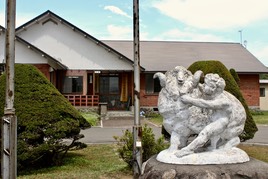
It was an honor to be invited to participate in the "Colloque international 'Haruki Murakami au présent et au futur’” back in March 2018, which took place in Strasbourg and Paris. Not only was the conference quite stimulating for someone who is not a Murakami specialist, it was a wonderful opportunity to encounter some new colleagues in the study of modern Japanese literature. It was, in some ways for me, an encore to the quite productive experience of participating in the French symposium on Kawabata Yasunari in September 2014 (from which I ended up publishing articles in Japanese and English). It was also inspiring to see many of the participants engage with Murakami in a deep and often critical manner. This is not a gathering of Murakami fans.
It is thus a great pleasure to see that many (though not all) of the papers at the Murakami colloquium have now been published in Japanese as Bunka hyosho toshite no Murakami Haruki (文化表象としての村上春樹 / Murakami Haruki as Cultural Representation) and includes a contribution by yours truly.
I am by no means a Murakami scholar, though perhaps a few things have brought us together. I have taught him and some films based on his literature before. I also had the pleasure getting to talk to him at length when Yale awarded him an honorary doctorate in 2017. It means nothing, but my brother-in-law was even once head of the agricultural research institute in Takikawa, Hokkaido, that—when it was focused on sheep farming—Murakami visited when researching A Wild Sheep Chase (photo below)!

I took the invitation to talk about Murakami as an opportunity to continue my writing on the relationship between cinema and Japanese literature that I began back when I was a graduate student (with articles like this and this). I don’t know how many foreign Murakami fans are conscious of this, but Murakami himself originally wanted to be a filmmaker (specifically, a scriptwriter) and even majored in film at Waseda University. So quite a number of scholars have written about not just the influence of cinema on his work, but also the many specific movie citations that appear in his literature.
Yet as I argued in the Kawabata article, the first issue should not be how cinema influences Murakami, but what cinema you are talking about when discussing that relationship. In my contribution to the Murakami anthology, I use the example of Inagaki Taruho, who like Murakami, seemed very attached to cinema at first only to later detach himself, to show one author who has a strong, though not always clear, conception of a cinema he advocates, and another that he rejects. Inagaki is a fascinating case of a modernist who celebrated early cinema and criticized how cinema developed after that (even though that later cinema was what other modernists tended to support); his relationship to cinema thus cannot be pursued without clarifying which cinema one is discussing. I argue something similar with Murakami. In his sole book written about film, A Wild Film Chase (Eiga o meguru boken, co-written with Kawamoto Saburo, 1985), he like Inagaki puts forward a nostalgic vision of cinema, in which a particularly ritualistic relationship to the medium has been lost with the arrival of television and the VCR. Considering that the type of cinema Murakami is attached to is defined by this form of singular, unrepeatable temporality, I try to connect that with the fact that, while Murakami is famous for resisting cinematic adaptations of his novels, he has largely accepted adaptations of his short stories. I speculate that the short mode—both short stories and short films—can its own form of temporality hold a key to understanding Murakami’s relation to film. In short, I argue that Murakami’s connection to cinema should start with an investigation of temporality.
I confess that the piece still remains somewhat speculative, and I look forward to seeing Murakami scholars taking the ball and running with it. What was reassuring at the colloquium was that a number of other scholars also took up the question of Murakami and cinema.
The anthology has just been published (in Japanese) by Seikyusha, and is edited by Ishida Hitoshi (Toyo University) and Antonin Bechler (University of Strasbourg). The variety of topics is impressive, from problems of translation, reception, nationality, and how to teach Murakami; to the representations of libraries, forests, travel, and disaster; to comparisons with Nagai Kafu, Furukawa Hideo, Natsume Soseki, and Ismael Kadare; and even connections with cinema, adaptation, and subculture.
The table of contents is too long to reproduce here, but here are the sections of the book along with the contributing scholars (the translations of section titles are my own):
- Part I: Murakami Haruki Seen through Translation and Comparative Literature
Stephen Dodd, Omura Azusa, Asahina Miwako, Anne Bayard-Sakai, Ishida Hitoshi - Part II: Representation in Murakami Haruki: Reality, Society, Narrative
Gerald Peloux, Hayakawa Kayo, Han Shukubun, Sugibuchi Yoichi, Brigitte Lefevre, Sugie Fumiko, Ishikawa Takao, Nonaka Jun - Part III: Affinity and Alienation with the Moving Image
Sukegawa Koichiro, Nakamura Miharu, Aaron Gerow, Giorgio Amitrano, Yonemura Miyuki - Part IV: Cultural Communication in Murakami Haruki
Antonin Bechler, Yokoji Aiko, Yokoji Keiko, Kimura Masaki
The bibliographic information for my contribution is as follows:
- Aaron Gerow, “Tanpen to iu jikansei: Murakami Haruki to eiga,” in Bunka hyosho toshite no Murakami Haruki: Sekai no Haruki no Yomikata, eds. Ishida Hitoshi and Antonin Bechler (Tokyo: Seikyusha, 2020): 226-239. ISBN 9784787292513
- アーロン・ジェロー「短編という時間制 村上春樹と映画」石田仁志、アントナン・ベシュレール編『文化表象としての村上春樹 世界のハルキの読み方』青弓社、2020年。
You can purchase it at Amazon.

